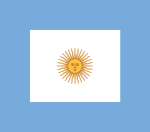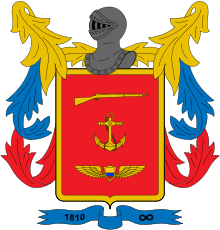Type 209 submarine
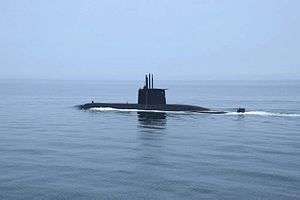 S41 (861), a Type 209/1400mod submarine of the Egyptian Navy, during sea trials. | |
| Class overview | |
|---|---|
| Builders: | |
| Operators: | See below |
| Preceded by: | Type 206 submarine |
| Succeeded by: | Type 214 submarine |
| Subclasses: | |
| In commission: | 1971-present |
| Planned: | 64 |
| Completed: | 61 |
| Cancelled: | 3 |
| Active: | 59 |
| Laid up: | 2 |
| General characteristics | |
| Type: | Type 209/1500 submarine |
| Displacement: | 1,810 tonnes (1,780 long tons) submerged |
| Length: | 64.4 metres (211 ft) |
| Beam: | 6.5 metres (21 ft) |
| Draft: | 6.2 metres (20 ft) |
| Propulsion: | Diesel-electric, 4 diesels, 1 shaft, 6100 shp |
| Speed: |
|
| Range: |
|
| Endurance: | 50 days |
| Test depth: | 500 metres (1,600 ft) |
| Complement: | 36 |
| Armament: |
|
The Type 209 is a class of diesel-electric attack submarine developed exclusively for export by Howaldtswerke-Deutsche Werft of Germany. The original variant (Type 209/1100) was designed in the late 1960s. Despite not being operated by the German Navy, five variants of the class (209/1100, 209/1200, 209/1300, 209/1400 and 209/1500) have been successfully exported to 13 countries, with 61 submarines being built and commissioned between 1971 and 2008.
Development
In the early 1970s, many navies began to need replacements for WWII-era submarines, aging United States GUPPY conversions, and British units transferred postwar.[6] During this time, few western submarine designs were available for export as most were large, expensive, sophisticated and difficult to operate and designed for the Cold War. Several designs originally built for specific nations were available including the French Daphne Class, British Oberon Class, and the Soviet Foxtrot Class submarines.[7] The design, designated by the German Ministry of Defense as the “Type 209” provided a solution providing the combination of size, performance, relative ease of operation for small or inexperienced navies, reasonable price and economy of operation.[8]
Design
The submarine was designed by Ingenieur Kontor Lübeck (IKL) headed by Ulrich Gabler and is largely based on previous German submarine designs (in particular the Type 206) with increased equipment. The design is single hulled and allows the commanding officer to see the entire submarine from the bow to stern while standing at the periscope.[7] Four 120-cell batteries are located forward and aft of the command center in the lower deck and make up about 25% of the boat's displacement.[6] Two main ballast tanks with forward and aft trim tanks allow the boat to dive. They are powered by four MTU diesels and four AEG generators.[8] The AEG electric motor is attached directly to a five- or seven-bladed propeller.
Armaments
Type 209 submarines are armed with 8 bow 533 mm torpedo tubes and 14 torpedoes. The Type 209/1200s used by Greece and South Korea, and the Type 209/1400s used by Turkey are also armed with Sub-Harpoon missiles.[9] Ships used by South Korea can be armed with 28 mines in place of torpedoes and Harpoon missiles; while the Indian ships can carry 24 mines externally.[4]
The class can be armed with a variety of torpedo models depending upon the country. The majority of boats carry SUT - Surface and Underwater Target (Greece, India, Indonesia, South Africa, South Korea) or the SST - Special Surface Target (Argentina, Peru, Turkey's 209/1200s, Venezuela) torpedoes. The boats can also carry the Mark 24 Tigerfish (Brazil, Turkey's Preveze class 209/1400), DM2A3 (Colombia), Blackshark (Chile), A184 mod. 3 (Ecuador),[4] DM2A4 (Turkey's Gür class 209/1400) and Mark 37 (Argentina).
Brazil’s boats will receive new integrated combat systems from Lockheed Martin to enable use of the Mark 48 torpedo.[2] Successful tests of the new combat system occurred on Tapajó S-33 in December 2011.[10]
Variants
Five variants of this submarine have been produced: Type 209/1100, Type 209/1200, Type 209/1300, Type 209/1400 and Type 209/1500. The U-209PN ordered by the Portuguese Navy is actually a Type 214.[11] The first three Dolphin class submarines built for the Israeli Navy are based on the Type 209 although heavily modified and enlarged.
Several modifications have occurred in the class resulting in these variants including the fitting of newer diesel engines. New air conditioning and electronics features have been added to accommodate orders from South America. The displacement in some variants has increased by nearly 50% in order to install new equipment, modernize accommodations, and extend range.[12]
The team of Ingenieur Kontor Lübeck (IKL) and Howaldtswerke-Deutsche Werft (HDW) proposed an enlarged Type 209 submarine, the Type 2000, for the Collins class submarine program.[13] The proposed design was roughly 500 tons more than the Type 209/1500's for India and lost to the Type 471 from Kockums, an enlarged Västergötland class submarine.
The Thomson class built for the Chilean Navy has escape hatches fitted in the torpedo and engine room. An additional aft hatch is fitted in the sail with access to the machinery.[14] The boats are fitted with higher masts to compensate for regional ocean wave conditions.
The Tikuna class built by the Brazilian navy is a modified Type 209/1400. The boat is 0.85 m longer and fitted with higher power diesels, different electric motors, batteries, electronics and sensors.
The Shishumar class built for and by India is unique for having an IKL-designed integrated escape sphere. The sphere has accommodations for the entire crew with an eight-hour air supply.[15]
The Sabalo class built for Venezuela was slightly lengthened during a modernization at HDW in the early 1990s. The increased length is due to the addition of a new sonar dome that is similar to the model found on the German Type 206.[1]
Between 2004 and 2006, the Indonesian Type 209/1300 submarine Cakra underwent a refurbishment by Daewoo Shipbuilding & Marine Engineering in South Korea. The refurbished submarine featured new batteries, overhauled engines, and modernized combat system.[16] Both submarines' existing STN Atlas-Elektronik CSU 3-2 sonar suite were replaced with L-3 ELAC Nautik's LOPAS 8300 passive sonar system and Kongsberg MSI-90U MK2 CMS.[17] In 2009, Daewoo won another order to refurbish Nanggala, which was completed in early 2012.[18]
It is also possible to upgrade these submarines with the latest Air-independent propulsion (AIP) systems. The first ships to receive this upgrade were to be three ships of the Greek Poseidon class Type 209/1200 under the Neptune II upgrade program.[19] They were to be upgraded by cutting the boat in half aft of the control room and adding a 6 m plug with a 120 kW Siemens AIP system to the ship.[14][20] The program was canceled in 2009 due to cancellation of the Archimedes Project (Type 214), but not before Okeanos (S118) completed the upgrade.[21] After the Archimedes Project settlement was reached, it was decided that instead of upgrading the remaining two Type 209s, two additional Type 214 ships were to be ordered, but that deal was cancelled by Howaldtswerke-Deutsche Werft.[22][23]
Chang Bogo upgrades/variant
The South Korean Chang Bogo-class submarines (Hangul: 장보고급 잠수함, Hanja: 張保皐級潛水艦) have reportedly been heavily upgraded in the 21st century,[24] which if undertaken was supposed to include domestic hull stretch augmentation from 1,200 tons to 1,400 tons and installment of domestically developed Torpedo Acoustic Counter Measures (TACM).[25] Some upgrades could have been affected or altered due to Korean economic problems of the late 1990s, which modified other plans to acquire nine 1,500-ton AIP-equipped boats or upgrade six 1200 boats to 1,500-tons AIP-equipped boats,[25][26][27] although the more ambitious plan to acquire nine 1,800-ton Type 214 AIP submarines was preserved and put under progress, not unaided by the quick recovery of the South Korean economy in 1999,[28] which will reportedly be wrapped up in 2018 when all submarines of the type are scheduled to be commissioned. LIG Nex1 began producing TACM for unspecified submarine types of the ROKN as well, which finished development in 2000.[29][30] Outfitting of the submarines with Sub-Harpoon launching capability was a part of the upgrade,[25] and seems to have been carried out on several submarines by 2008.[4][31][32] They can equip the White Shark heavy torpedo,[29][33][34] and can possibly equip submarine-launched Hae Sung anti-ship missiles later on.[35][36] AIP and flank-array sonars are planned for future modernizations.[37]
In December 2011, Daewoo won a contract to build Indonesia three 1,400-ton Chang Bogo-class submarines for $1.07 billion.[38] Construction of the submarines will start in January 2012 for delivery by 2015 and 2016, for commissioning in the first half of 2018. They'll be equipped with torpedoes and guided missiles.[39] The submarines are described to be Korea's original model, bigger and more advanced than Indonesia's refurbished Type 209/1300.[40] Initially the offered submarines were going to be in-service ROKN submarines.[41] The sale will be done without the involvement of German companies.[42] South Korea is currently the only country outside Germany independently offering the Type 209 for sale. Indonesia was also offered two license built Type 209 submarines manufactured by a group of Turkish (SSM - Undersecretariat for Defense Industries) and German companies (HDW/ThyssenKrupp), a deal reported to be valued at $1 billion.[43] SSM was also offering the leases of Type 209 submarines until new submarines could be completed.[42] The offer has since been superseded by the DSME submarine contract. The three new submarines would be equipped with the Kongsberg MSI-90U MK2 combat systems, Indra's Pegaso RESM system and Aries-S LPI radar.[44]
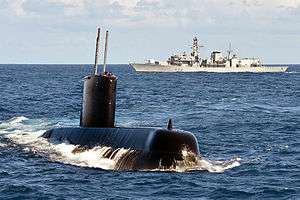
Service
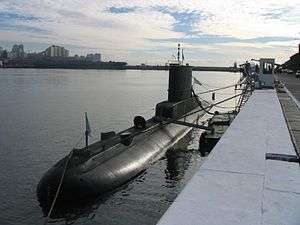
.jpeg)
Countries operating the Type 209 include Argentina, Brazil, Chile, Colombia, Ecuador, Greece, India, Indonesia, Peru, South Africa, South Korea, Turkey and Venezuela. All Type 209s remain in service except for ARA San Luis (S-32) which was stricken in 1997 after an incomplete overhaul and Glavkos (S-110) decommissioned in 2011. Iran had an order for six Type-209 submarines that was cancelled by Grand Ayatolla Khomeini in 1979, following the Iranian Revolution.[45]
The first user was the Hellenic Navy which purchased four Type 209/1100 and four Type 209/1200 submarines.
The largest operator of the Type 209 is the Turkish Navy which operates six Type 209/1200 submarines (commissioned between 1976 and 1989) and eight Type 209/1400 submarines (commissioned between 1994 and 2007). At present, the Turkish Navy is also the largest operator of German designed submarines in the world.
Three new Type 209/1400 submarines were delivered to South Africa in 2006, costing $285 million each.
Type 209s are often supplemented with other submarine designs or are scheduled to be replaced by them. Argentina received two TR-1700 class submarines (Santa Cruz class) during the 1980s. Ten Kilo class submarines were purchased by India in the 1980s and 90s (Sindhughosh class submarine), along with Akula class submarine INS Chakra in 2011. Two Scorpène class submarines have been commissioned by Chile, while Brazil has four and India has six ships ordered or under construction. Nine Type 214 submarines (Son Won-il class) are commissioned, building, or planned by South Korea to supplement its force, while Greece is replacing its aging Glavkos class with four Type 214 submarines (Papanikolis class), and Turkey will be replacing early Atılay class ships with six Type 214 submarines.[46]
During the Falklands War the Argentinian Type 209/1200 submarine San Luis performed a war patrol. While on their way to the area assigned the fire control computer went out of order. The vessel continued on to the combat area, and managed to fire at least 3 wire guided SST-4 mod0 torpedoes at the British fleet. The torpedoes suffered from various issues, with the guide wire cut a minute after launch and the torpedoes going off the assigned course. After the war testing revealed that the torpedoes' electric gyroscopes had reversed polarity, which resulted in a complete refit of the entire Argentinean torpedo stock, and a conversion of a portion of this stock from Mod0 to Mod1, performed by the firm which produced these weapons (AEG). Beside the torpedo issue, San Luis patrolled mostly undetected.[47][48]
_Type_209-1400-class_submarine.jpg)
Egypt initially ordered two Type-209/1400mod submarines in 2011 and later ordered two more in 2014.[49] The shipbuilder TKMS started building the first submarine S41 (861) in March 2012, the vessel was launched in December 2015 after 57 months of construction work.[50] The Egyptian Navy received the S41 in December 2016, the second submarine S42 was launched during the same month.[51][52] In April 2017, The S41 arrived at its home port in Alexandria and officially entered service, after a long journey from Kiel. Before reaching its naval base, the S41 conducted its first naval exercise with other units from the Egyptian Navy, ensuring its readiness to join the fleet.[53] The Egyptian submarines have 8 x 21-inch (533 mm) torpedo tubes and are able to carry and launch up to 14 missiles and torpedoes, in addition to deploying naval mines. They will be fitted with SeaHake mod 4 torpedoes and UGM-84L Harpoon Block II missiles.[54][55]
Technical specifications
| 1100 | 1200 | 1300 | 1400 | 1500 | |
|---|---|---|---|---|---|
| Displacement (submerged) | 1,207 t | 1,285 t | 1,390 t | 1,586 t | 1,810 t |
| Dimensions | 54.1 × 6.2 × 5.9 m | 55.9 × 6.3 × 5.5 m | 59.5 × 6.2 × 5.5 m | 61.2 × 6.25 × 5.5 m | 64.4 × 6.5 × 6.2 m |
| Pressure Hull Diameter | 6.8 m | ||||
| Propulsion | Diesel-electric, 4 diesels, 1 shaft | ||||
| 5,000 shp | 6,100 shp (4,500 kW) | ||||
| 4 x 120-cell batteries | 4 x 132-cell batteries | ||||
| Speed (surface) | 11 knots (20 km/h) | 11.5 knots | |||
| Speed (submerged) | 21.5 knots | 22 knots | 22.5 knots | ||
| Range (surface) | 11,000 nmi (20,000 km) at 10 knots (20 km/h) | ||||
| Range (snorkel) | 8,000 nmi (15,000 km) at 10 knots (20 km/h) | ||||
| Range (submerged) | 400 nmi (700 km) at 4 knots (7 km/h) | ||||
| Endurance | 50 days[56] | ||||
| Maximum depth | 500 m | ||||
| Armament |
8 x 533 mm torpedo tubes
| ||||
| Crew | 31 | 33 | 30 | 36 | |
Operators
| Operator | Class Name | Type | Notes | ||||
|---|---|---|---|---|---|---|---|
| 1100 | 1200 | 1300 | 1400 | 1500 | |||
| Salta class | 1(1*) | ARA Salta (S-31) underwent midlife upgrades from 1988 to 1995 and 2004 to 2005. (*) ARA San Luis (S-32) stricken in 1997 after incomplete overhaul. | |||||
| Tupi class Tikuna class | 4(1*) | (*) The Tikuna (S-34) is a modified Type 209/1400. Additional modified Type 209/1400 Tapuia (S-35) cancelled. All Type 209's will be fitted with new combat systems capable of using the Mk.48 torpedo.[2] | |||||
| Thomson class | 2 | SS Simpson (SS-21) is scheduled for refit and upgrade in ASMAR, Chile this year. SS Thompson (SS-20) refit and upgrade was completed in early 2009, this works include integration of SUBTICS combat management system and BlackShark torpedoes. | |||||
| Pijao class | 2 | Both scheduled to be upgraded between 2009 and 2011 in the state-owned shipyard COTECMAR, with the assistance of HDW.[57] | |||||
| Shyri class | 2 | SS Shyri (S101) is under modernization in ASMAR, Chile since 2009; was slightly damaged after the tsunami in Talcahuano. SS Huancavilca (S102) is under modernization in ASMAR, Chile since November 15, 2011 with completion scheduled for 2014.[58] | |||||
| Type-209/1400mod class | 4 | S41 (861) officially entered service in April 2017.[53] S42 (864) was handed over to the Egyptian Navy in August 2017.[59] | |||||
| Glavkos class Poseidon class | 3(1*) | 4 | Glavkos class overhauled under the Neptune I program from 1993 to 2000. Poseidon class Neptune II upgrade program cancelled, but not before Okeanos (S118) completed the upgrade.[21] (*) Glavkos (S-110) was decommissioned on June 9, 2011.s | ||||
| Shishumar class | 4 | Option for two additional Indian built boats not taken up after several reviews.[3] Equipped with integrated escape sphere for full crew. Underwent midlife refits from 1999 to 2005, talks underway with HDW for additional upgrades.[60] | |||||
| Cakra class Chang Bogo class | 2 | 3 | KRI Cakra was refitted by Daewoo Shipbuilding & Marine Engineering, South Korea between 2004 and 2006. KRI Nanggala refit contract was awarded to Daewoo in 2009 and completed in 2012.[18] (*) Indonesia has awarded DSME a contract for three 1,400 ton Chang Bogo class submarines in December 2011. All three vessels will be commissioned by the first half of 2018. | ||||
| Chang Bogo class | 9 | ||||||
| Islay class Angamos class | 2 | 4 | Both 209/1100 (Islay class) were locally upgraded in 2008. Upgrade of the 209/1200 (Angamos class) is in process. | ||||
| Heroine class | 3 | Commissioned between 2006 and 2008 replacing Daphné-class boats. | |||||
| Atılay class Preveze class Gür class | 6 | 8 | Atılay class mid-life refit with AIP propulsion cancelled. Early Atılay class ships will be replaced by Type 214 submarines starting in 2020.[46] Modernization for S-351 Doğanay and S-352 Dolunay will include new periscopes, ESM, and Inertial Navigation Systems.[61] | ||||
| Sabalo class | 2 | Sabalo modernized in the state-owned shipyard DIANCA from 2004–2011, included new computer, engineering, mast, and snorkel systems. | |||||
Individual Boats
| Country | Class name | Type | Pennant | Name | Commissioned | Decommissioned |
|---|---|---|---|---|---|---|
| Salta class | 1200 | S-31 | Salta | 1974 | ||
| Salta class | 1200 | S-32 | San Luis | 1974 | 23 April 1997 | |
| Tupi class | 1400 | S-30 | Tupi | 1989 | ||
| Tupi class | 1400 | S-31 | Tamoio | 1994 | ||
| Tupi class | 1400 | S-32 | Timbira | 1996 | ||
| Tupi class | 1400 | S-33 | Tapajó | 1999 | ||
| Tupi class | 1400mod | S-34 | Tikuna | 2005 | ||
| Thomson class | 1400L | SS-20 | Thomson | 1984 | ||
| Thomson class | 1400L | SS-21 | Simpson | 1984 | ||
| Pijao class | 1200 | S-28 | Pijao | 1975 | ||
| Pijao class | 1200 | S-29 | Tayrona | 1975 | ||
| Shyri class | 1300 | S101 | Shyri | 1977 | ||
| Shyri class | 1300 | S102 | Huancavilca | 1978 | ||
| Type-209/1400mod class | 1400mod | 861 | S41 | 2017 | ||
| Type-209/1400mod class | 1400mod | 864 | S42 | 2017 | ||
| Glavkos class | 1100 | S-110 | Glavkos | 1971 | 9 June 2011 | |
| Glavkos class | 1100 | S-111 | Nirefs | 1972 | ||
| Glavkos class | 1100 | S-112 | Triton | 1972 | ||
| Glavkos class | 1100 | S-113 | Protefs | 1972 | ||
| Poseidon class | 1200 | S-116 | Poseidon | 1979 | ||
| Poseidon class | 1200 | S-117 | Amfitriti | 1979 | ||
| Poseidon class | 1200AIP | S-118 | Okeanos | 1979 | ||
| Poseidon class | 1200 | S-119 | Pontos | 1979 | ||
| Shishumar class | 1500 | S44 | Shishumar | 1986 | ||
| Shishumar class | 1500 | S45 | Shankush | 1986 | ||
| Shishumar class | 1500 | S46 | Shalki | 1992 | ||
| Shishumar class | 1500 | S47 | Shankul | 1994 | ||
| Cakra class | 1300 | 401 | Cakra | 1981 | ||
| Cakra class | 1300 | 402 | Nanggala | 1981 | ||
| Nagapasa class | 1200 | 403 | Nagapasa | 2016 | ||
| Nagapasa class | 1200 | 404 | Ardadedali | 2017 | ||
| Nagapasa class | 1200 | 405 | Alugoro | Planned in 2018 | ||
| Chang Bogo class | 1200 | SS-061 | Chang Bogo | 1993 | ||
| Chang Bogo class | 1200 | SS-062 | Lee Chun | 1994 | ||
| Chang Bogo class | 1200 | SS-063 | Choi Museon | 1996 | ||
| Chang Bogo class | 1200 | SS-065 | Park Wi | 1996 | ||
| Chang Bogo class | 1200 | SS-066 | Lee Jongmu | 1996 | ||
| Chang Bogo class | 1200 | SS-067 | Jeong Un | 1998 | ||
| Chang Bogo class | 1200 | SS-068 | Lee Sunsin | 2000 | ||
| Chang Bogo class | 1200 | SS-069 | Na Daeyong | 2000 | ||
| Chang Bogo class | 1200 | SS-071 | Lee Eokgi | 2001 | ||
| Angamos class | 1200 | SS-31 | Angamos ex-Casma | 1980 | ||
| Angamos class | 1200 | SS-32 | Antofagasta | 1980 | ||
| Angamos class | 1200 | SS-33 | Pisagua ex-Blume | 1982 | ||
| Angamos class | 1200 | SS-34 | Chipana ex-Pisagua | 1983 | ||
| Islay class | 1100 | SS-35 | Islay | 1975 | ||
| Islay class | 1100 | SS-36 | Arica | 1975 | ||
| Heroine class | 1400mod | S101 | Manthatisi | 2005 | ||
| Heroine class | 1400mod | S102 | Charlotte Maxeke | 2007 | ||
| Heroine class | 1400mod | S103 | Queen Modjadji | 2008 | ||
| Atılay class | 1200 | S-347 | Atılay | 1976 | 30 November 2016 | |
| Atılay class | 1200 | S-348 | Saldıray | 1977 | 2014 | |
| Atılay class | 1200 | S-349 | Batıray | 1978 | ||
| Atılay class | 1200 | S-350 | Yıldıray | 1981 | ||
| Atılay class | 1200 | S-351 | Doğanay | 1984 | ||
| Atılay class | 1200 | S-352 | Dolunay | 1989 | ||
| Preveze class | T1.1400 | S-353 | Preveze | 1994 | ||
| Preveze class | T1.1400 | S-354 | Sakarya | 1995 | ||
| Preveze class | T1.1400 | S-355 | 18 Mart | 1998 | ||
| Preveze class | T1.1400 | S-356 | Anafartalar | 1999 | ||
| Gür class | T2.1400 | S-357 | Gür | 2003 | ||
| Gür class | T2.1400 | S-358 | Çanakkale | 2005 | ||
| Gür class | T2.1400 | S-359 | Burakreis | 2006 | ||
| Gür class | T2.1400 | S-360 | Birinci İnönü | 2007 | ||
| Sabalo class | 1300 | S-31 | Sabalo | 1976 | ||
| Sabalo class | 1300 | S-32 | Caribe | 1977 |
Pictures
 Argentine Navy submarine Type 209 Class (S-31) ARA "Salta" at Mar del Plata naval base.
Argentine Navy submarine Type 209 Class (S-31) ARA "Salta" at Mar del Plata naval base._assist_the_crew_of_the_Colombian_Navy_submarine_Pijao_(SO_28)_to_pull_in_on_board_Naval_Station_Mayport%2C_Fla.jpg) Colombian Navy submarine Pijao (SO 28) in Naval Station Mayport, Florida participating in Exercise Smart Search 2005.
Colombian Navy submarine Pijao (SO 28) in Naval Station Mayport, Florida participating in Exercise Smart Search 2005. Republic of Korea (ROK) Chang Bogo Type 209/1200 Submarine Nadaeyong (SS 069) surfacing during a SINKEX for Rim of the Pacific RIMPAC 2002.
Republic of Korea (ROK) Chang Bogo Type 209/1200 Submarine Nadaeyong (SS 069) surfacing during a SINKEX for Rim of the Pacific RIMPAC 2002.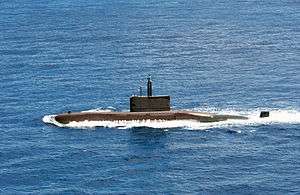 Republic of Korea (ROK) Chang Bogo Type 209/1200 Submarine Chang Bogo heads out to sea during exercise Rim of the Pacific (RIMPAC) 2004.
Republic of Korea (ROK) Chang Bogo Type 209/1200 Submarine Chang Bogo heads out to sea during exercise Rim of the Pacific (RIMPAC) 2004._at_Pearl_Harbor_on_21_June_2004_(040621-N-5539C-001).jpg) CS Simpson (SS-21) prepares to render honors to the USS Arizona Memorial as the submarine pulls into port in Pearl Harbor, Hawaii.
CS Simpson (SS-21) prepares to render honors to the USS Arizona Memorial as the submarine pulls into port in Pearl Harbor, Hawaii..jpg) South African submarine Type 209/1400 (Heroine class) Charlotte Maxeke (S-102).
South African submarine Type 209/1400 (Heroine class) Charlotte Maxeke (S-102).
See also
![]()
References
- 1 2 Saunders, Stephen (2004). Jane's Fighting Ships 2004-2005. Jane's Information Group. p. 900. ISBN 0-7106-2623-1.
- 1 2 Webmaster I. "Bharat-Rakshak.com :: NAVY - Shishumar Class". Archived from the original on 4 October 2014. Retrieved 19 December 2014.
- ↑ "Industry Directory".
- 1 2 John Pike. "Type 209". Retrieved 19 December 2014.
- 1 2 "THE WORLD OF TYPE 209 SUB". Retrieved 19 December 2014.
- 1 2 Miller, David (2002). The Illustrated Directory of Submarines. Zenith Press. p. 480. ISBN 0-7603-1345-8.
- ↑ Watts, Anthony (2006). Jane's Warship Recognition Guide. Harpercollins. p. 384. ISBN 0-00-718327-5.
- ↑ "Lockheed Martin Submarine Combat System Successfully Tested in Brazilian Navy Sea Trials". Retrieved 19 December 2014.
- ↑ "Submarino de ataque (SSK) classe Tridente (tipo U-214)". Retrieved 19 December 2014.
- ↑ ThyssenKrupp Marine Systems - Class 209 / 1400mod Archived 2011-04-24 at the Wayback Machine.
- ↑ Woolner, Derek (18 September 2001). Procuring Change: How Kockums was Selected for the Collins Class Submarine. Canberra: Department of the Parliamentary Library. p. 34.
- 1 2 Watts, Anthony (March 2002). Jane's Underwater Warfare Systems, 2002-2003. Jane's Information Group. p. 629. ISBN 0-7106-2451-4.
- ↑ ARG. "Shishumar Class Patrol Submarine - Military-Today.com". www.military-today.com.
- ↑ "Defense & Security Intelligence & Analysis: IHS Jane's - IHS". Retrieved 19 December 2014.
- ↑ "L3 ELAC Nautik Newsletter 2009/2010" (PDF). Archived from the original (PDF) on 2012-04-25. Retrieved 2011-10-26.
- 1 2 "대우조선해양, 인도네시아 잠수함 성능개량사업 완료". 보도자료 배포, 온라인 보도자료 등록, 홍보 대행 - 뉴스와이어. Retrieved 19 December 2014.
- ↑ "Naval Highlights from Defendory 2006". Archived from the original on 2014-12-19. Retrieved 19 December 2014.
- ↑ "Submarino de ataque (SSK) classe Poseidon / 209-1200 (tipo U-209)". Retrieved 19 December 2014.
- 1 2 "The Odyssey: Greece's U-214 Submarine Order". Defense Industry Daily. 8 October 2014. Retrieved 19 December 2014.
- ↑ "Press release - Press releases - ThyssenKrupp AG". 3 December 2014. Retrieved 19 December 2014.
- ↑ Termination of subcontract with HSY by HDW
- ↑ ARG. "Chang Bogo Class Patrol Submarine - Military-Today.com". www.military-today.com.
- 1 2 3 "Defense & Security Intelligence & Analysis: IHS Jane's - IHS". Retrieved 19 December 2014.
- ↑ Kim, Duk-Ki (2000). Naval Strategy in Northeast Asia: Geo-strategic Goals, Policies and Prospects. Routledge. p. 30. ISBN 0-7146-4966-X.
- ↑ Meconis, Charles; Wallace (2000). East Asian Naval Weapons Acquisitions in the 1990s: Causes, Consequences, and Responses. Praeger. p. 229. ISBN 0-275-96251-2.
- ↑ "South Korea GDP - real growth rate". Retrieved 19 December 2014.
- 1 2 "www.tradeKorea.com". Retrieved 19 December 2014.
- ↑ "True Dream Partner - LIG Nex1". Archived from the original on 12 October 2015. Retrieved 19 December 2014.
- ↑ "Honolulu Star-Bulletin Hawaii News". Retrieved 19 December 2014.
- ↑ RIMPAC Exercise and Republic of Korea Navy
- ↑ "White Shark". www.deagel.com.
- ↑ "South Korea's weapons story Domestic torpedo Great White".
- ↑ John Pike. "ASM/SSM-700K Sea Star (Haesung / Haeseong / Haesong)". Retrieved 19 December 2014.
- ↑ "Defense & Security Intelligence & Analysis: IHS Jane's - IHS". Retrieved 19 December 2014.
- ↑ "Introduction of Republic of KOREA Navy". Retrieved 19 December 2014.
- ↑ "RI orders 3 submarines worth $1b in regional 'catch-up'". Retrieved 19 December 2014.
- ↑ South Korea Exports Submarines to Indonesia
- ↑ "Korea wins $1 bil. Indonesian deal". 20 December 2011.
- ↑ "Defense & Security Intelligence & Analysis: IHS Jane's - IHS". Retrieved 19 December 2014.
- 1 2 "ECONOMY - Turkey, Germany seek submarine sale of $1 bln". Retrieved 19 December 2014.
- ↑ "ECONOMY - Turkey denies losing deal for Indonesian Navy submarines". Retrieved 19 December 2014.
- ↑ "Indra to implement its technology in Indonesia's type 209 submarines for more than €10M". Archived from the original on 19 December 2014. Retrieved 19 December 2014.
- ↑ John Pike. "Iran Navy Modernization". Retrieved 19 December 2014.
- 1 2 Turkey Specifies a Range of New Ships
- ↑ Günther Stiller (7 August 2007). "Marine: Deutsches U 24 schlich sich bei Manöver unentdeckt an amerikanischen Flugzeugträger - Das Zielfoto, das einen US-Admiral wütend machte - Politik - Ausland - Hamburger Abendblatt". Hamburger Abendblatt. Retrieved 19 December 2014.
- ↑ Lessons of the Falklands. Department of the Navy (Report). DTIC. February 1983. ADA133333. Retrieved 2 June 2015.
- ↑ "Egyptian naval commander receives Type-209 submarine from Germany".
- ↑ "Naval units lining up to celebrate the arrival of the first Type 209 submarine in Alexandria" (in Arabic).
- ↑ "Egypt takes delivery of first Type 209 submarine".
- ↑ "Egypt receives first Type 209 submarine from German TKMS".
- 1 2 "Egypt raises flag on first-ever German Type 209/1400 attack submarine".
- ↑ "Ägyptens Marine taucht in Kiel ab" (in German).
- ↑ "Egypt - UGM-84L Harpoon Block II Encapsulated Missiles". 13 May 2016.
- ↑ "Type 209 Diesel-Electric Attack Submarine (1971)". Military Factory. Military Factory. 2016-04-14. Retrieved 2016-08-29.
- ↑ "Press release - Press releases - ThyssenKrupp AG". 3 December 2014. Retrieved 19 December 2014.
- ↑ Ecuadorian submarine docked in Asmar Talcahuano Archived 2012-01-07 at the Wayback Machine.
- ↑ "Egypt receives second Type-209 submarine from Germany".
- ↑ "India in talks with Germany to upgrade HDW vessel capabilities". Zee News. Retrieved 19 December 2014.
- ↑ Ay-Class Submarine To be Modernized By STM Archived 2011-10-06 at the Wayback Machine.
External links
- ThyssenKrupp Marine Systems - Class 209/1400mod
- Active Diesel submarines - 2002
- Argentine Navy website - Submarine Force - ARA Salta (S-31) specifications
- Global Security
- Haze Gray & Underway: World Navies Today - (Pre-2003 developments)
- Hellenic Navy's Submarine OCEANOS (S-118) 3d animation
- Shishumar Class
- The U209 Family Evolution
- U209 operators map
